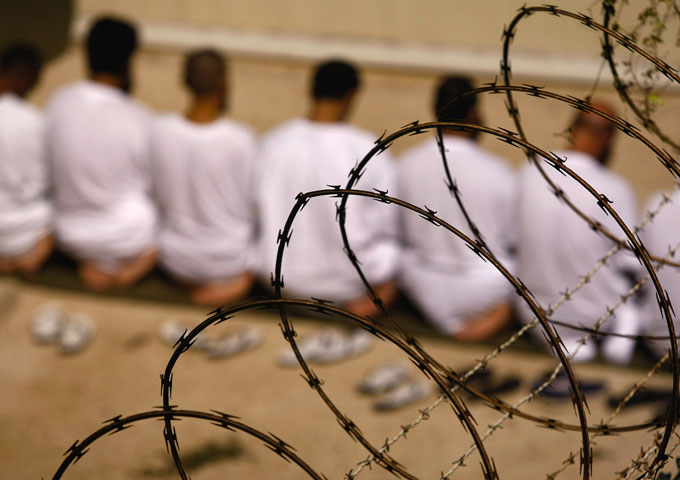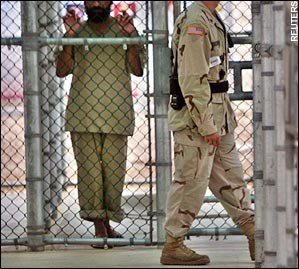Gitmo Dilemma Remains a Monkey on the Back of U.S. Democracy

Setting the Habitat for Violence
Guantanamo Bay Detention Camp detainees have been living in a state of legal limbo and their patience apparently has come to an end. Over the years, there have been repeated complaints from already released prisoners, as well as from the 166 who remain in the camp, that security personnel have carried out immeasurable counts of torture against the inmates, along with other questionable control tactics. Some of those who have been granted release are unable to return to their homelands out of concern for their safety, while other countries, including the United States, are refusing to house them after their release. After years of uncertainty, it is not surprising that detainees have gone to extreme measures over the years to protest their current legal status and living conditions. The most recent incident has been an ongoing hunger strike involving a number of detainees, many of whom have been living on water alone since February 6.
The United States established the prison at the U.S. naval base in Guantanamo Bay, Cuba, after the September 11, 2001 terrorist attacks, as a means of detaining terrorist suspects or persons allegedly linked to terrorist organizations. The prison has been an ongoing point of controversy, regarding the fact that the prisoners of Guantanamo are not granted the same legal rights guaranteed to prisoners of U.S. forces. In the 11 years since the prison’s opening, there are still many detained with no trial date in sight. Perhaps of greater concern, 86 of the 166 detainees remain in the prison even though they were approved for release from the detention camp three years ago. [1]
At the start of his first term, President Obama vowed to close the controversial detention camp in the U.S.-operated region of Guantanamo Bay, Cuba, within his first year as president. He repeated this promise during an interview on The Daily Show with Jon Stewart when he was campaigning for re-election in 2012. Nevertheless, four years later the White House has made only minimal efforts to fulfill this promise, and Congress has blocked any attempt to shut down the center. The consequence of such inaction has been an increase in the unrest felt by prisoners and opponents of the prison alike.
Prisoners Ban Together in Protest
With every year that passes, prisoners of the detention camp have grown more and more restless with the uncertainty of their status and treatment while in the prison. This culminated on February 6, 2013, when a small number of Guantanamo prisoners began an internal protest by refusing to eat their meals. In the days that followed, solidarity among prisoners grew, resulting in a large-scale demonstration. The exact number of those involved is unclear, but on April 1, the U.S. Department of Defense announced that roughly 40 prisoners are taking part in the strike and 11 have needed to be force-fed liquid nutrients to keep them alive. [2] This is a very different story than what is being told by some lawyers of the detainees who have declared that the strike, in reality, involves the majority of the inmates, with the exception of the elderly and ill, bringing the total to 130 of the 166 inmates. [3]

The protest allegedly began as a result of detainees’ unrest regarding their current status in the prison, as well as a recent seizure of the prisoners’ personal belongings. For some, the strike is fundamental in nature in that their motivation for protest stems from their ongoing imprisonment. Many, like Marine General and Commander of SOUTHCOM John Kelly, an overseer of Guantanamo Bay, are frustrated by the lack of movements coming out of the U.S. government to close the camp, “‘They had a great optimism that Guantanamo would be closed’ based on President Obama’s pledge in his first campaign, but now they are “devastated” that nothing has changed.” [4] Captain Robert Durand, a U.S. military spokesperson, in an April 13 statement announced that the strike began after Guantanamo Bay prison staff had seized prisoners’ letters, photos, and other personal belongings. Most notably, detainees became enraged by the treatment of personal copies of the Koran that have been used in the course for personal worship. According to Guantanamo lawyers, prisoners feel as though the manor in which their Korans were handled during the seizer was not only inappropriate, but also sacrilegious. [5]
Conflict Reaches New High
On Saturday, April 13, tensions reached an all time high. Early that morning, a new series of cell raids took place at the prison, a measure deemed necessary by guards after detainees allegedly covered window and security cameras installed at the compound. Violence erupted when troops arrived to transfer prisoners out of Camp 6, a communal section of the prison reserved for well-behaved detainees to enjoy additional freedoms, such as additional recreation time and access to T.V.s and computers were recalled. When prison guards arrived for the transfer of detainees back to their individual cells, the detainees began to fight the prison guards with broomsticks and mop handles, while guards responded by firing four nonlethal rounds, including a modified shotgun shell that fired small rubber pellets as well as a bean-bag projectile, according to a spokesman for the Florida-based U.S. Southern Command Army Colonel Greg Julian. [6] my site

U.S. authorities have stated that Camp 6, though closed indefinitely, will reopen when prisoners are obedient once again. For now, Durand believes that keeping prisoners in individual cells is the best way to keep an eye on the protesting detainees, as prison personnel are hoping to avoid the spread of the hunger strike through interactions between prisoners granted access to Camp 6. Lawyers, however, do not see this action as a means to an end, but rather of pushing the prisoners to new extremes. One federal public defender in Ohio, Carlos Warner, stated, “This is exactly the opposite of what they should be doing. As of last week, the strike would end if they allowed the men to surrender the Koran. Instead the military is escalating the conflict.” [7] In contrast, it has been suggested that a negotiation between prisoners and prison guards as a method of finding an end to the ongoing hunger strike; however, hatred and distrust between the two groups will likely impede any negotiations from being fruitful.
Searching for a Resolution
There is no clear solution to better relations between staff members and inmates. In a March 26 statement, Captain Durand said,
They have presented no demands that we can meet–we will not admit to Koran abuse, which did not take place, we will not exempt the Koran from search, which will continue to be in a respectful manner, and we will not accept the detainees’ offer to ‘turn in’ their Korans and deprive them of the religious articles needed to practice their faith. [8]
Such property searches are not an uncommon practice for Guantanamo prison guards; however, prisoners have taken a stance to actively protest this measure deemed necessary by such personnel. The cause of the strike cannot be solely attributed to the confiscation of personal belongings and subsequent unrest. It is more likely that the seizure will trigger manufactured protests after years of mounting tensions and frustration felt among the prisoners.
Demonstrations against the state of detainees have not been confined to the prison alone. Captain Durand is adamant that the strike was, “[an] orchestrated event intended to garner media attention,” and if this is the case, the inmates have succeeded. Human rights advocates around the world are calling for the U.S. government to finally take necessary action to stop such violations of international principles of humanitarian law against the Guantanamo Bay detainees, namely through the ultimate release of the inmates. On April 1, Yemeni activists went to the U.S. Embassy in Sanaa demanding the release of inmates native to their country, who make up the largest percentage of prisoners at the detention camp, and many of who are partaking in the hunger strike. [9] Within the United States, human rights groups have been adamant that the government must shut down the prison; however, their efforts have had little impact.
It is clear that closing the detention camp is not one of President Obama’s top priorities this term, and thus the responsibility of the inmates on strike lay in the hands of the prison guards, if the president is to completely abandon his campaign promise. It became increasingly obvious on March 21 that closing was not in the detention camp’s immediate future with the proposal from U.S. Southern Command for $49 million USD to expand prison facilities. [10]
Security personnel at Guantanamo have the ability to come to an agreement with inmates to stop the nearly month long strike, which continues to hospitalize more and more participating prisoners each day. For these inmates, it appears as though there is no end in sight as Guantanamo lawyer, David Remes, indicated that, “These men, including many of my clients, say they are determined to leave Guantanamo one way or the other–or…in a box.” [11]
Regardless of their innocence or their guilt, the prisoners of the Guantanamo Bay Detention Camp have been living in a state of legal limbo. After 11 years, these prisoners feel they have the right to understand and determine their fate, be it release for those already granted release or trial for those who have yet to be convicted. Until then, unrest will be felt between prisoners and civilian protesters alike and inevitably will continue to be felt around the world.
Megan Cowell, Research Associate at the Council on Hemispheric Affairs
Please accept this article as a free contribution from COHA, but if re-posting, please afford authorial and institutional attribution. Exclusive rights can be negotiated.
For additional news or analysis on Latin America, please go to: Latin News

